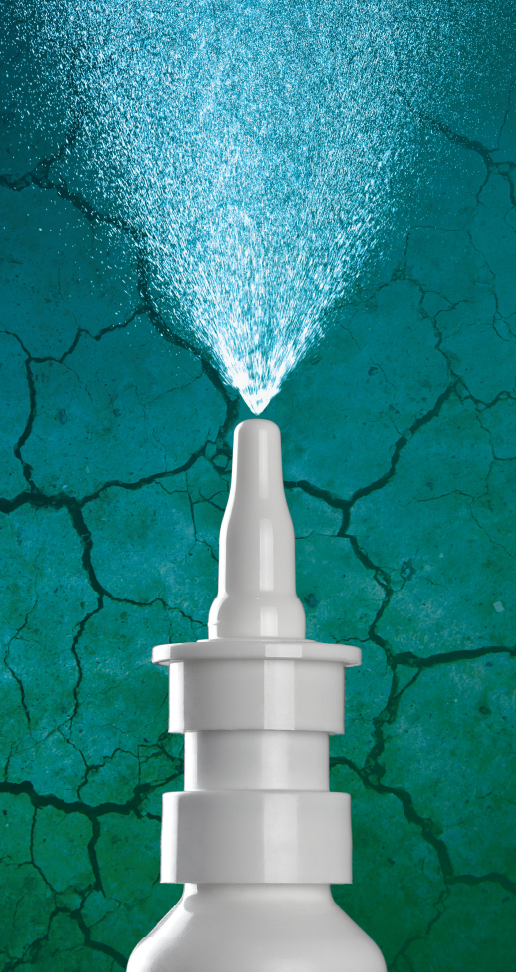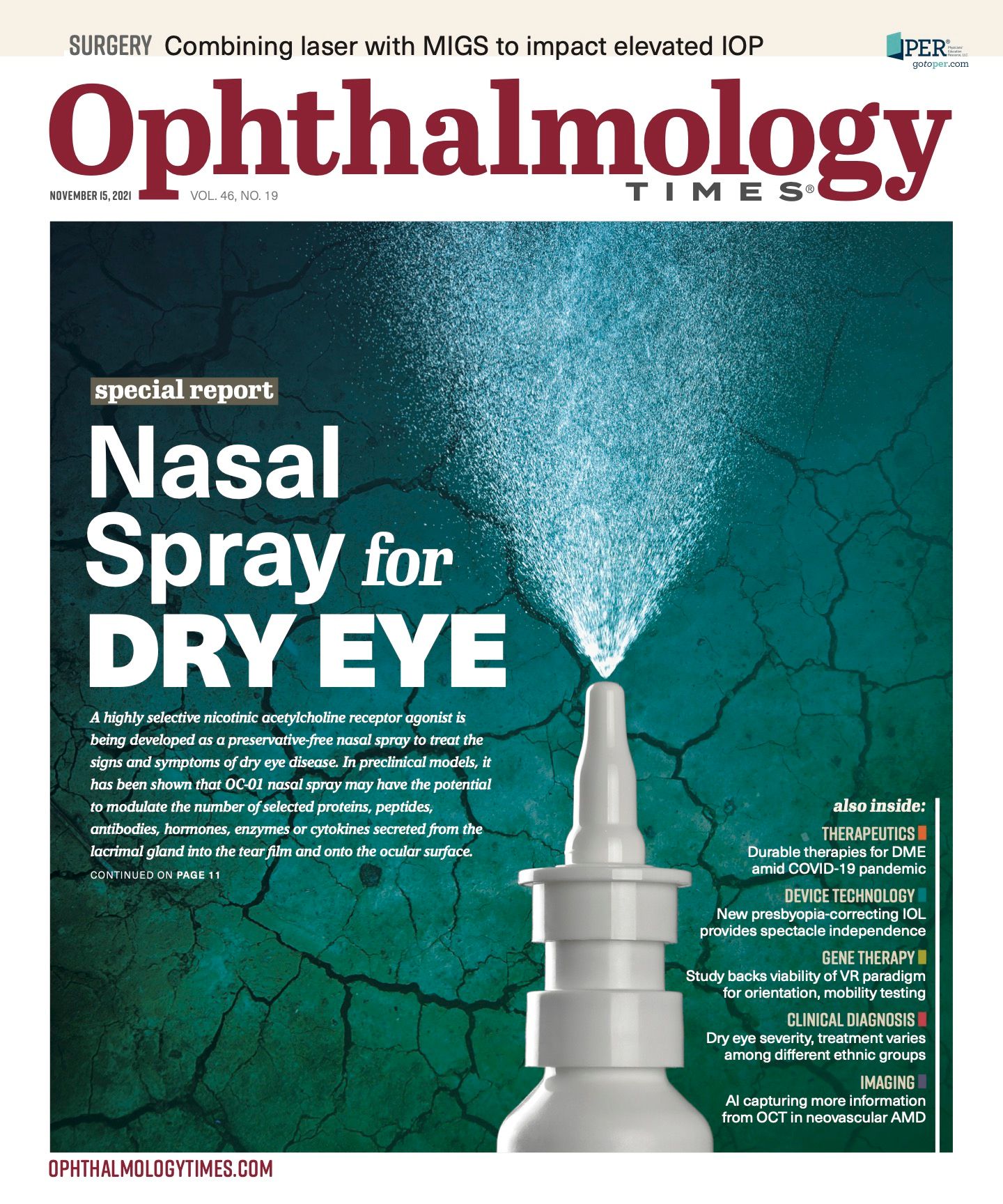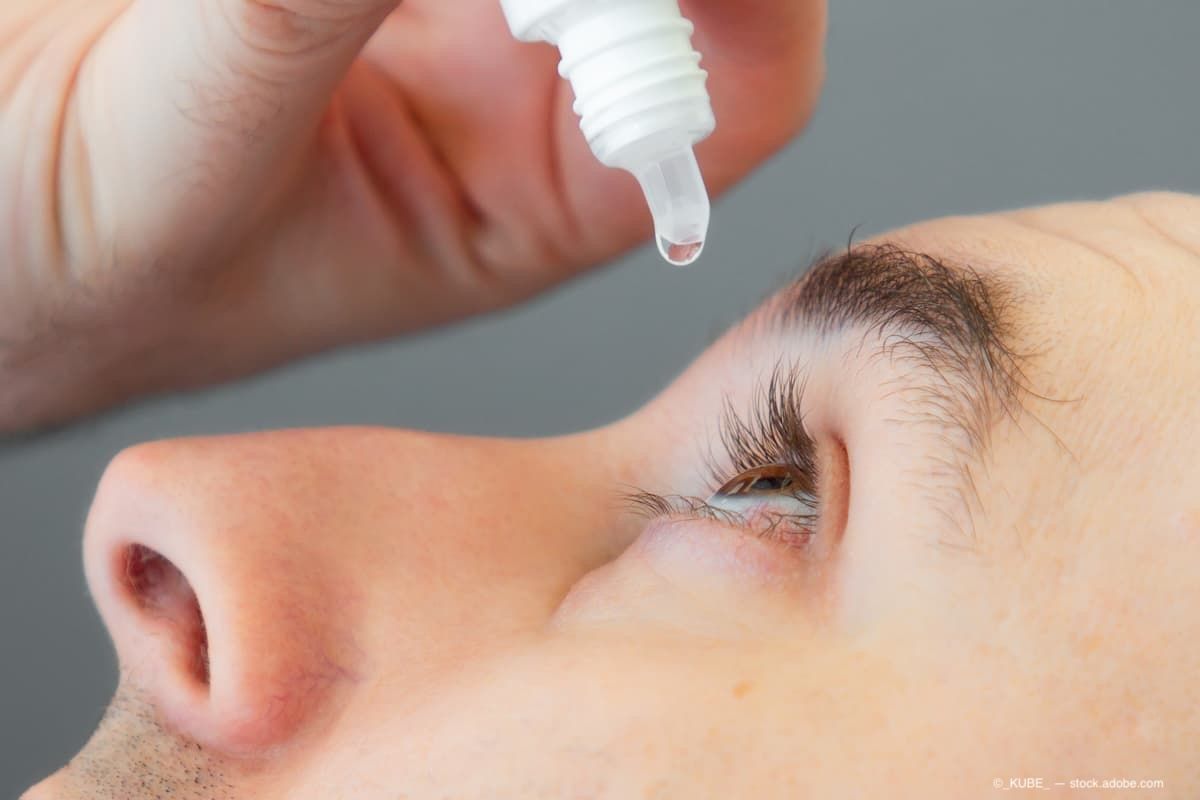Publication
Article
Digital Edition
Varenicline nasal spray approved as a treatment for dry eye disease
Author(s):
Product stimulates basal tear production, restores tear film homeostasis, and relieves symptoms.

Reviewed by Marian Macsai, MD
The FDA’s approval of varenicline nasal spray 0.03 mg (Tyrvaya, Oyster Point Pharma) for the treatment of the signs and symptoms of dry eye disease (DED) brings to the management of this common condition a new therapeutic modality that is novel for both its mechanism of action and mode of administration.
The new medication is recommended to be used twice daily, sprayed once into each nostril.
As a highly selective nicotinic acetylcholine receptor agonist, varenicline is designed to bind to cholinergic receptors in the nasal mucosa and activate the trigeminal parasympathetic pathway, resulting in increased production of basal tear film.
Related: Oyster Point Pharma reports FDA approval of TYRVAYA nasal spray for DED treatment
Results from preclinical and clinical studies show that varenicline nasal spray induces goblet cell degranulation and stimulates meibomian gland and lacrimal gland secretion.
Unlike most prescription topical treatments for DED, varenicline nasal spray 0.03 mg aims to reestablish tear film stability/homeostasis, according to Marian Macsai, MD, chief medical officer of Oyster Point Pharma in Princeton, New Jersey.
“Tyrvaya brings innovation to patients...with DED,” Macsai explained. “It is the first and only nasal spray approved for the treatment of the signs and symptoms of DED, and it is the first and only pharmacological approach to cholinergic neuro-activation via the trigeminal parasympathetic pathway.”
Macsai pointed out that as a new approach to drug delivery for DED, nasal spray administration offers the benefit of avoiding instillation of medication onto an already irritated ocular surface.
“Acting through a novel mechanism of action, Tyrvaya provides a clinically meaningful increase in basal tear film production to provide relief for [patients with DED] as early as 4 weeks after treatment initiation,” Macsai said. “The clinical trial data also showed benefit was achieved in a broad patient population of adults with mild, moderate, or severe DED.”
Related: Researchers pioneer technology that leads successful clinical trial to treat dry eye disease
Jeffrey Nau, PhD, MMS, president and CEO of Oyster Point Pharma, said the approval of Tyrvaya marks a step forward for patients with DED and eye care professionals by providing a new treatment option for the signs and symptoms of DED with a unique route of administration by leveraging nerves that can be accessed in the nose.
“In any therapeutic area, it is always an exciting moment when you follow the science and develop a truly innovative solution for patients that addresses an important medical need. This approval marks that moment for the eye care community as we bring forward a whole new way of treating dry eye disease through a convenient nasal spray that activates the body’s natural tear film production,” he said.
Nau added that the company currently is looking forward to making the treatment option available to eye care professionals and their patients.
Basis for approval
The FDA approval of varenicline nasal spray is based on findings from 3 randomized, masked, vehicle-controlled clinical trials—MYSTIC (NCT03873246), ONSET-1 (NCT03636061), and ONSET-2 (NCT04036292)—that included more than 1000 patients with mild, moderate, or severe DED.
The phase 2 MYSTIC study was a single-site clinical trial study with a 12-week duration.
Related: Expert insights: Flares of dry eye disease
ONSET-1 was a phase 2b, vehicle-controlled dose-ranging study, and ONSET-2 was a phase 3 pivotal trial comparing 2 concentrations of the varenicline nasal spray against a placebo.
To be eligible for enrollment in these studies, patients had to have a baseline anesthetized Schirmer score of 10 mm/5 min or less with a cotton swab nasal stimulation and corneal fluorescein staining scores of 2 to 14.
The patients also could have mild, moderate, or severe symptom severity based on having an eye dryness score (EDS) of 0 to 100. Patients in the ONSET studies had to have an Ocular Surface Disease Index score of 23 or higher.
Participants in the premarketing clinical trials were predominantly female (74%) and older adults (mean age 61 years). At baseline, they had a mean anesthetized Schirmer score of 5.1 mm/5 min and mean EDS of 59.3.
MYSTIC had a real-world design as it had no placebo run-in period and patients were allowed to use artificial tears during the study period.
Related: Treatment Options for Dry Eye Flares
Data on change in Schirmer score in the MYSTIC trial showed improvement as early as day 7, which was maintained through the 12-week study without evidence of tachyphylaxis.
The primary end point in both ONSET-1 and ONSET-2 was the proportion of eyes achieving a 10 mm or greater increase in Schirmer score from baseline to week 4.
It was met in both trials with statistical superiority of varenicline 0.03 mg compared with placebo (P ≤ .01).
In ONSET-1, 52% of patients treated with varenicline 0.03 mg met the primary end point compared with 14% of vehicle-treated controls.
In ONSET-2, 47% of patients treated with varenicline 0.03 mg and 28% of placebo-treated patients achieved a 10 mm or greater increase in Schirmer score from baseline at week 4.
Related: Expert insights: Flares of dry eye disease
Mean change in Schirmer score from baseline to week 4 also was analyzed and shown to be significantly greater in the varenicline 0.03 mg groups compared with placebo in both ONSET-1 (11.7 vs 3.2 mm) and ONSET-2 (11.3 vs 6.3 mm) (P ≤ 0.01 for both comparisons).
Patients treated with varenicline 0.03 mg also benefited with greater improvements in EDS compared with controls.
Changes in EDS were assessed in the controlled adverse environment in ONSET-1 and in the clinic environment in both ONSET trials.
In addition, a subgroup analysis stratifying patients into those with mild-to-moderate or severe DED based on their EDS showed that the benefit was achieved regardless of disease severity and that the magnitude of improvement was greater in the severe group.
Treatment with varenicline nasal spray 0.03 mg for a period of up to 105 days was safe and well tolerated.
Related: Optimizing the management of DED
Sneezing after administration was the most common adverse effect associated with its use, being reported by 82% of patients. With very few exceptions, patients categorized the sneezing as mild. In patients who reported sneezing, 98% rated it as mild.
No patients treated with Tyrvaya discontinued their participation in the clinical study due to sneezing.
Other adverse effects in the varenicline treatment groups included cough, throat irritation, and instillation site (nasal) irritation, and they occurred at rates of 5% to 16%.
Newsletter
Don’t miss out—get Ophthalmology Times updates on the latest clinical advancements and expert interviews, straight to your inbox.





